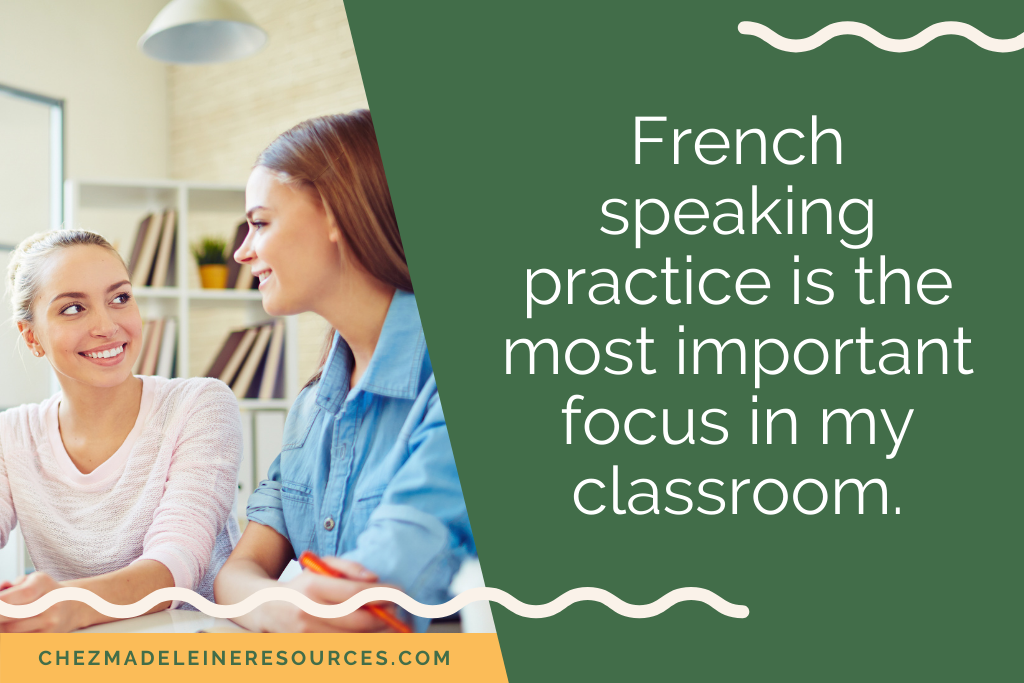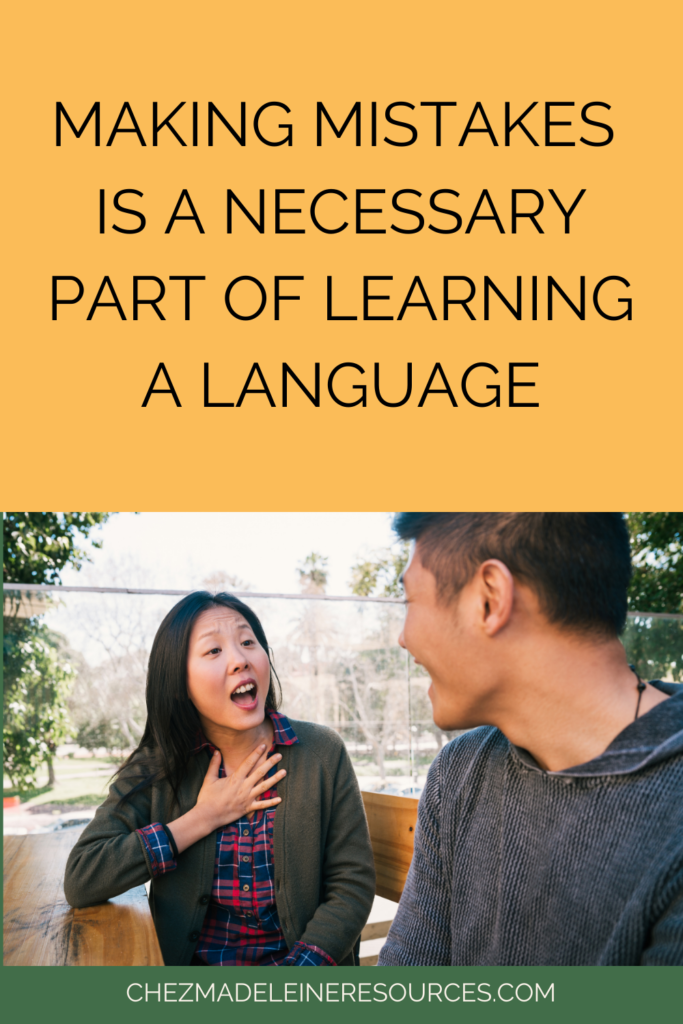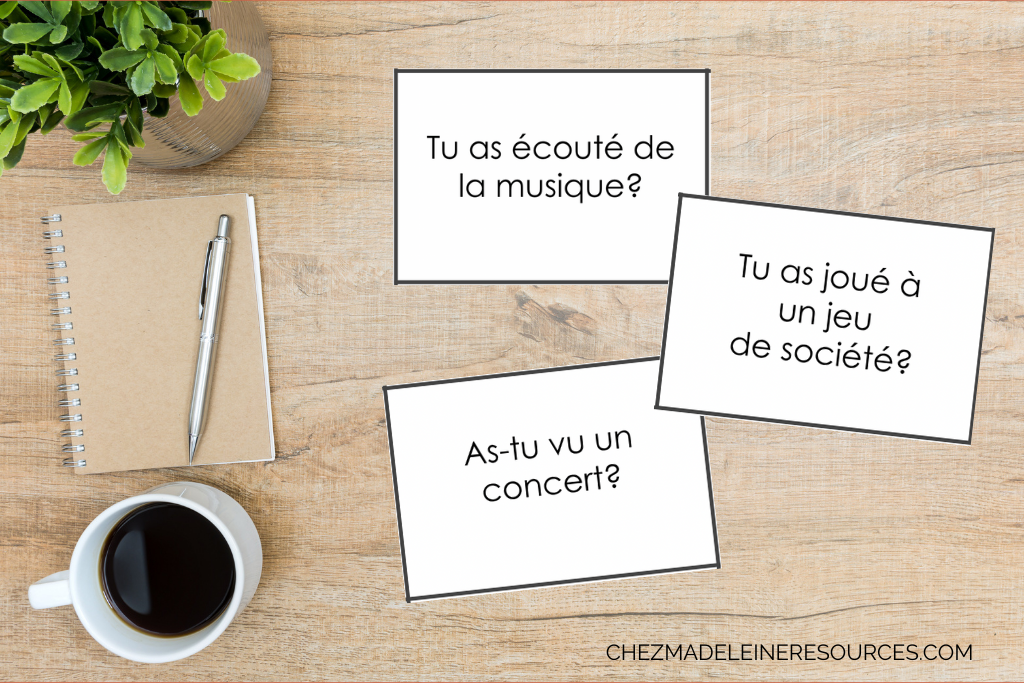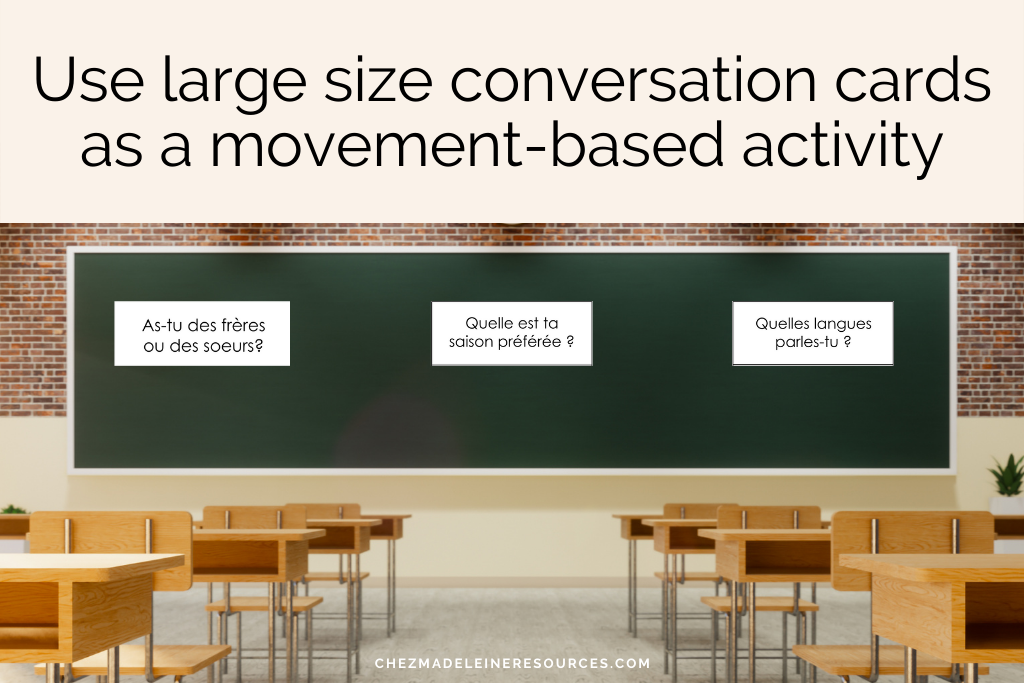I love using conversation questions in my French class to get students talking. Admittedly, I did not use French conversation prompts very often when I first started out and that’s because I was worried about getting through “the content” – ie all the grammar, verb tenses, slideshows, worksheets, tests etc. However, now I realize that French speaking practice should be the biggest priority in the classroom. Speaking French is the whole point of the class! And so, that’s why I like using conversation cards to break the ice and get students talking in French!

How do you facilitate French speaking practice?
For me, it’s important to set the tone and expectations of French speaking practice before diving in with the conversation questions. I like to remind students that making mistakes is a necessary and unavoidable part of learning a language.

I also share some of my own personal experiences in learning languages to help normalize the nervousness that can come with speaking French. For example, the first week I moved to France I went to an apéritif and felt so self-conscious about my French language skills that I spent most of the evening petting the cat to avoid speaking to anyone! I tell them this is not the experience I want for them, and that’s why we’re going to do lots of French speaking practice in class!
It’s also important to me that when using the French conversation cards, it’s clear that it’s just for practice! Grammar and pronunciation are not being evaluated. Of course, students should be aiming to speak correctly, but there’s no one breathing down their neck to make sure they get it perfect. It needs to be an environment in which trying is praised, not perfection.
What are the best questions for conversation starters?
The best conversation questions are those that the students can relate to. I’m always tempted to ask them questions about travelling experiences because, for me, that’s what a lot of my French language experiences are associated with. But then I have to remember that my students are all under 18 and many have never left the country before.
Moreover, I want to be conscious of the different economic situations of my students. Some might travel internationally with their families every spring break, whereas others might be lucky to visit a neighbouring city once every couple of years. Even though learning French will help facilitate international opportunities later in life, I don’t want to alienate students from learning the language because they haven’t been privileged enough to experience that yet.

French conversation questions depend on the level of the students
Another factor I consider is the level of the students and what my goal for them is in using the conversation cards. For lower-level learners, the questions might be more closed, for example, “Est-ce que tu aimes danser?” However, even with these closed questions, I encourage students to answer back in full sentences, not just a yes or no answer.
Here is a FREE deck of conversation cards that is appropriate for lower-level students and focusses around introductions and getting to know one another.
For my higher-level students, the conversation questions are an opportunity for them to explore and have fun with the language. More open-ended questions are good for this level as they can bring in their own opinions, outside knowledge and interests. It’s at the higher levels that the question cards can really spark back and forth conversations.

Conversation questions that focus on grammar concepts
A lot of time I make conversation questions purposefully around a specific grammar topic, like the passé composé, because I want students to get comfortable with that tense. So often when I learned grammar in French class it was only in the written form, and speaking it felt heavy and slow. The more we can take grammar and verb tenses off of the page and into a real interaction between people, the more students will understand the value of learning a language.
I have the following decks of conversation cards that focus specifically on the passé composé:
–Le week-end
–Le week-end – with the verb aller
–As-tu déjà?
10 fun ways to use conversation questions in your French class
Below is a list I have compiled of the many ways you can use French conversation questions in your classroom. As you will see, although the conversation cards are originally intended to facilitate French speaking practice, you can also use them as writing prompts.
#1 Use question cards for a “Speed Friending” activity
I love this activity because it is low-risk for the students. They are only talking to one other person at a time, while everyone else is talking too, so no one is looking at them or listening to them!
Group students into two lines facing one another (or inner and outer circles) and give each student a question card. Students ask and answer one another’s questions and then once everyone is done, one of the lines shifts down a person so everyone is faced with someone new. Repeat over and over again so students get to answer lots of new questions.
You can also do this where after the students have asked one another their questions, they switch cards before rotating to the next person. This way, students aren’t asking the same conversation prompt 10+ times in a row.

#2 Use French conversation questions for a whole-class “Question du Jour” activity to start each day
I like this activity for helping to build a strong classroom community. It is also a more teacher-directed way of using the conversation questions and therefore can be good for lower-level students as a way for the teacher to help demonstrate how to ask and answer questions.
Using the slides, each morning project one of the questions on the board. Ask individual students to answer the question from the desk. To give more comprehensible input, you can ask follow-up questions to that individual student, repeat what they say and elaborate on it, share your opinion, and ask for a show of hands as to who agrees etc.
Alternatively, you can get students to turn to the person next to them to discuss the question prompt. This is a good option if you have a shyer class or have less time.

All of my French conversation card decks come with a slides version of the questions in order to run a Question du Jour activity. Click here to see all my French question cards.
#3 A student-centred “Question du Jour” variation
This activity I learned from a teacher in France while I was working with her as an English language assistant. Every class, students began by standing at their desks. She wrote a question on the board and one student started the activity by asking another student in the class the question. That student would answer and then ask another student the same question, and so on and so on. Once a student had answered and asked the question, they sat down so that it was clear who still hadn’t had a turn yet.
I liked this activity because there was a lot of repetition. For those that were struggling with the pronunciation, they could listen to their peers say the question over and over again until it was their turn. It was also nice to hear from every single student, especially when the questions ask them to share their favourite x, you get to know everyone a little bit more. The whole activity also only takes about 5 minutes so it’s a nice quick warm-up to get everyone’s brains on for the class.
#4 Use conversation questions as a partner warm-up to begin class
This French-speaking activity is a nice way to begin the class because it requires you to greet each student at the door as they enter. As the students enter, you hand each one of them a question card from the deck. When they sit down, they ask and answer the questions with a partner.
You can repeat this activity a lot because students will generally get handed a different card each day. These kinds of partnered activities can be a nice slow warm-up start to a class, especially in the mornings when those teens are still half asleep!
If you’re super organized, you can lay a card on each students’ desk before they enter the classroom so it is waiting for them when they arrive.

#5 Fast-finishers can use the question cards to produce a written response
I’m guilty of often allowing early finishers to go on their phone. It’s such a battle with cell phones with some students that this is often my concession – you don’t take it out until you’re done with all your work. But, I would like to get better at keeping the phones in the bags the whole class. If you’ve already managed to do this – good on you! Conversation cards are a great way to keep those fast-finishers occupied with meaningful work that is related to the class content.
#6 Set up stations for small group work
I like this use of the conversation cards because it involves movement! Create a few stations around the room, each with a few question cards on the table. Have students move around in small groups to each of the stations and discuss the questions. I like to set a time limit for each station and have groups all rotate at the same time to avoid congestion at certain stations.
#7 Facilitate a mingling game to get students moving
Give each student a card, have them stand up, and then put on a song in the background. While the song is playing, students walk around the room and as soon as you stop the song, they have to turn to the person closest to them. They each ask and answer one another’s questions and then swap cards. Play the music again and repeat!.
#8 Partnered walk-and-talk activity
Use the large version of the French conversation cards and post them around the room or on the board. Students walk around in pairs asking and answering the questions. If it makes sense to do so, students can write their answers below the questions.

#9 Have you ever game
This French-speaking activity is a fun game that you can play in small groups. For this, you need to be using questions that follow the proper format “As-tu déjà?” I have a deck made just for this purpose which you can find here.
Each group of students is given one deck of cards. Each student holds up 5 fingers to start the game. They take turns pulling a card and asking the question to everyone in the circle. Each person has to answer the question. If you have higher levelled students, you can encourage them to share a bit of detail about the experience. If the students have done the thing the question asks, they put down a finger. The person who runs out of fingers first wins!
Once students are familiar with the game, you can have them play where they make up the questions.
#10 Exit-cards
If you have an extra 5 minutes at the end of class, you can project one of the questions on the board and have students write a written answer to the question and turn it into you before leaving. Exit cards are a great way to do formative assessments.
Check-out these pre-made decks of French Conversation Cards:
Looking for more French-speaking practice ideas?
Here are some links to blog posts by other educators which talk about some more great ideas for getting students talking in French class!
4 Fun Classroom Games Guaranteed to Get Your French Students Talking
Five Fun French Speaking Activities to Review for Finals
Effective Tools and Strategies to Boost Students’ Speaking Proficiency








